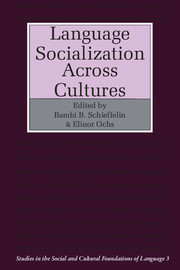Book contents
- Frontmatter
- Contents
- List of contributors
- 1 Introduction
- Part I Acquiring language and culture through interactional routines
- Part II Acquiring knowledge of status and role through language use
- Part III Expressing affect: input and acquisition
- 8 Teasing and shaming in Kaluli children's interactions
- 9 Teasing: verbal play in two Mexicano homes
- 10 Teasing as language socialization and verbal play in a white working-class community
- 11 The acquisition of communicative style in Japanese
- 12 From feelings to grammar: a Samoan case study
- Index
9 - Teasing: verbal play in two Mexicano homes
Published online by Cambridge University Press: 05 June 2012
- Frontmatter
- Contents
- List of contributors
- 1 Introduction
- Part I Acquiring language and culture through interactional routines
- Part II Acquiring knowledge of status and role through language use
- Part III Expressing affect: input and acquisition
- 8 Teasing and shaming in Kaluli children's interactions
- 9 Teasing: verbal play in two Mexicano homes
- 10 Teasing as language socialization and verbal play in a white working-class community
- 11 The acquisition of communicative style in Japanese
- 12 From feelings to grammar: a Samoan case study
- Index
Summary
Teasing a child is a behavior that seems specifically designed to create uncertainty in the recipient of the tease. Although the teaser does not actually intend the literal content of his or her utterance to be accepted as true, teasing creates the possibility that the child will believe the utterance to be true. According to Grice's (1975) maxim of quality, speakers should not say anything they believe to be untrue; yet in teasing children, adults intentionally violate this maxim. The question to be addressed in this chapter is why adults choose to tease children and thereby create this type of uncertainty in them.
Although descriptions of teasing are rare in the literature on interactions involving young children, there are enough data to indicate that explanations of teasing must focus on a particular cultural or subcultural group (Coles 1977; Heath 1981; Miller this volume; Schieffelin this volume; Simmons 1942). Teasing has been shown to vary across groups in its structural characteristics, assignment of roles permissible for children, and association with other speech forms, such as criticism, joking, and assertion. Thus, the specific focus of this chapter will be the teasing that occurred in the interactions of two Mexican immigrant families living in northern California.
The suggestion to be made is that while there are common characteristics shared by all teasing sequences, at any particular time the specific goal of the teaser may vary.
- Type
- Chapter
- Information
- Language Socialization across Cultures , pp. 182 - 198Publisher: Cambridge University PressPrint publication year: 1987
- 8
- Cited by

